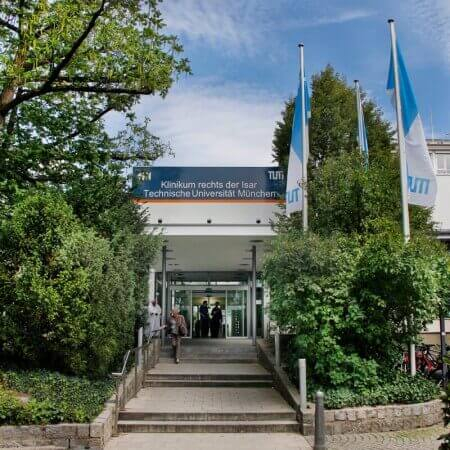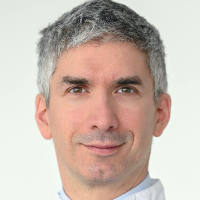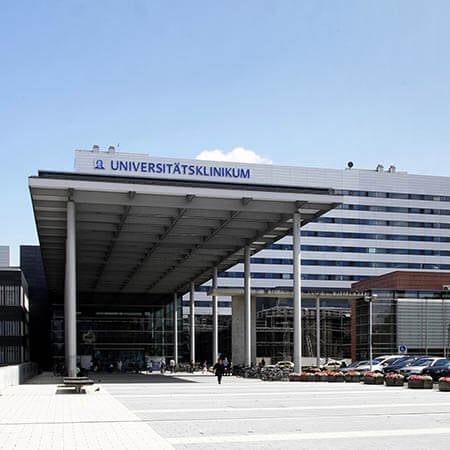Keratoconus — Circular Keratotomy: treatment in the Best Hospitals of Germany
Treatment prices are regulated by national law of the corresponding countries, but can also include additional hospital coefficients. In order to receive the individual cost calculation, please send us the request and medical records.

Department of Adult and Pediatric Ophthalmology
The Department of Adult and Pediatric Ophthalmology offers the full range of modern diagnostic and therapeutic services in the field of its expertise. The department deals with the treatment of all pathologies of the anterior and posterior segment of the eye. Special attention is paid to operations on the retina, vitreous body, lens and treatment of corneal diseases. To provide effective treatment, the department has three modern operating rooms and two treatment rooms equipped with the very latest technology. The department has 24 beds. Most of the diagnostic and therapeutic procedures are performed on an outpatient basis, without mandatory hospitalization. The department's medical team admits more than 2,500 inpatients, and about 25,000 outpatients for diagnostics and treatment annually. The department’s specialists have long successful experience and they also deal with the most complex clinical cases. They provide effective treatment that meets the highest European standards.




Department of Adult and Pediatric Ophthalmology
The Department of Adult and Pediatric Ophthalmology offers modern diagnostics and treatment of diseases of the eye and its appendages. The main areas of the department's clinical activity include cataract surgery, vitreoretinal surgery, and the treatment of glaucoma, age-related macular degeneration, diabetic retinopathy, and eye injuries. The medical facility successfully performs corneal transplant surgery: DMEK lamellar keratoplasty (partial thickness corneal transplantation) and penetrating keratoplasty (full-thickness corneal transplantation). The department has a competent team of pediatric ophthalmologists who specialize in the treatment of retinopathy of prematurity, strabismus, amblyopia, nystagmus, eye injuries, and other eye diseases in children. The department also houses a Center for Intravitreal Therapy, where intraocular injections are performed for the treatment of macular and retinal diseases. Ophthalmologists have at their disposal state-of-the-art equipment, such as powerful laser systems, operating microscopes, ophthalmoscopes, refractometers, ultrasound devices, and many others. The department's specialists give preference to personalized care and apply the very latest therapeutic techniques that provide people with the opportunity to see the world in bright colors again







Department of Adult and Pediatric Ophthalmology
The Department of Adult and Pediatric Ophthalmology offers the full range of modern diagnostics and effective treatments for eye diseases. The department specializes in cataract, glaucoma, refractive eye surgery, surgical treatment of corneal, retinal and vitreous pathologies, correction of strabismus, surgical treatment of diseases of the eyelids and tear ducts. An integral part of the department's doctors work is the treatment of children with eye problems. The department is proud of its long history and exceptional experience in the field of its competence. It treats more than 30,000 outpatients and inpatients every year, which demonstrates the excellent reputation of the medical facility.





Keratoconus is one of the common causes of progressive loss of visual acuity. Its treatment in advanced stages usually requires a corneal transplant. German doctors, however, also use other treatment methods that preserve the patient's own cornea. Ophthalmologists perform circular keratotomy. This operation reshapes the cornea and strengthens it by forming scar tissue.
Content
Doctors make a circular incision, form a flap, and use a special program to calculate the amount of tissue to be removed. The "extra" tissues are then excised and sutured. The operation is well tolerated and improves vision.
You can undergo your treatment at the University Hospital Rechts der Isar Munich, the University Hospital Ulm, or the University Hospital Frankfurt am Main.
You are welcome to make your treatment appointment through the Booking Health service and we will organize your trip. The Booking Health team will make an appointment at the hospital with the necessary doctor on the preferred date, take care of your visa and preparation of medical documents, arrange flights and accommodation, provide an interpreter and a personal medical coordinator.
What is keratoconus?
Keratoconus is a change in the shape of the cornea. It takes the form of a cone, hence the name of the disease. The pathology is usually bilateral and genetically caused. The condition is constantly progressing, leading to visual impairment despite normal intraocular pressure and the absence of signs of inflammation.
As a rule, the disease begins in childhood. Gradually, the cornea becomes deformed and thinner, which leads to corneal myopia and astigmatism. In some countries, more than 2% of the population suffers from keratoconus. The highest prevalence of pathology is noted in India and Israel.
Treatment principles
In the early stages, keratoconus can be treated with conservative methods, and with the progression of the pathology, operations will be performed.
The objectives of the treatment of keratoconus in Germany are as follows:
- stabilization of the process so that the disease does not progress or develops more slowly;
- improvement of visual acuity to provide a better quality of life;
- advanced stages of the disease also require the elimination of structural disorders, for example, in the case of the threat of corneal perforation.
At an early stage of the disease, vision correction with lenses is sufficient. As the pathology progresses, invasive procedures and operations will be used. These may be CrossLinking, laser thermokeratoplasty, implantation of intrastromal corneal ring segments and MyoRing, deep anterior lamellar or penetrating keratoplasty, photorefractive and phototherapeutic keratectomy.
Circular keratotomy
Corneal transplantation is usually performed for advanced stages of the disease. The surgical procedure solves the problem of keratoconus, if not forever, then for a very long time. The treatment method, however, is associated with the following problems:
- a shortage of donor material;
- the graft's lifespan is limited;
- risk of immune complications;
- the need for repeated operations in the future, which is especially important for young patients.
Patients sometimes refuse a transplant due to their personal or religious beliefs. Therefore, there is an alternative treatment option for such people, namely circular keratotomy with corneal plastic surgery. This is a new treatment method, the essence of which is based on the reshaping of the patient's own cornea by partially removing tissues and applying interrupted sutures along mutually perpendicular meridians.
This is a non-penetrating operation that preserves the patient's own cornea. Doctors perform circular keratotomy at the first stage, usually with a femtosecond laser, and microsurgical removal of the formed flap with suturing is performed at the second stage. A mathematical model is used to calculate the amount of tissue to be removed. Accurate calculations ensure the best optical properties of the cornea.
The benefits of this method are as follows:
- improvement in vision the very next day after the operation;
- minimal rehabilitation period;
- excellent results for grade 2-3 keratoconus.
The best results of the operation can be achieved in the case of the central location of the apex of keratoconus.
You can use the services of the Booking Health company to undergo your diagnostics and circular keratotomy in Germany. On the website, you can find prices and select the most suitable hospitals. You can also compare the cost of services in different medical centers to make your treatment appointment at the best price. Our employees will help you to select the most suitable clinics in Germany and take care of the arrangements for your trip.
Authors:
The article was edited by medical experts, board-certified doctors Dr. Nadezhda Ivanisova and Dr. Vadim Zhiliuk. For the treatment of the conditions referred to in the article, you must consult a doctor; the information in the article is not intended for self-medication!
Sources:

